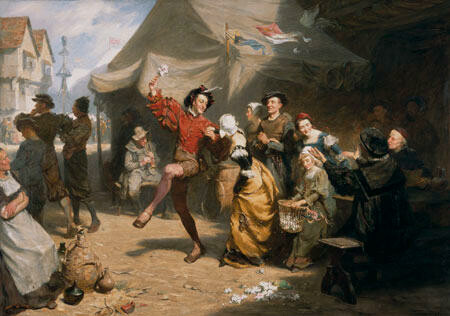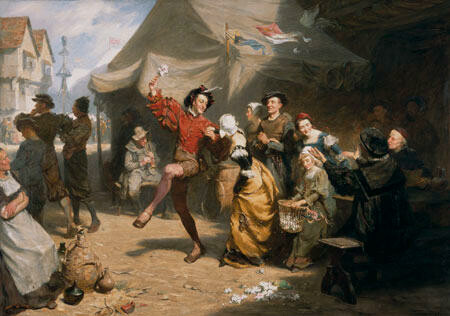B.
May Day by Fred Roe
Collection
This article first appeared in The Press as 'The whole is less than the sum of painting's various parts' on 22 September 2016
A former curator at this gallery sometimes played the game of deciding which works he would grab if the building caught fire. This exercise forced him to focus his mind closely on the significance of individual pieces, comparing works that were from different periods and countries, in a playful attempt to work out which was the really top stuff. I have to report that Fred Roe’s Victorian whimsy went down as one of the works that would be deliberately thrown back into the flames.
Old-fashioned and workmanlike are the kinder adjectives you could use. Clunky and pedestrian would be closer to it. The stiffness of the people, the soupy brown palette, the vagueness of the period setting, and the painting’s overall awkwardness add up to not much.
We now have access, however, to Fred Roe’s daybook in the archives of the Royal Academy, in which the details of how this painting was created are recorded in excruciating detail. This daybook provides a fascinating insight into how a painting like this was made. And ‘made’ is the right word because we can see that the painting was assembled from its component parts in the same way that you might assemble a sideboard.
Starting top left we see from his records that Roe spent 23 to 28 May 1895 in Evesham where he sketched the houses and presumably the maypole. Back in his London studio he then spent much of 1895 and indeed 1896 hiring models for the characters in the foreground: Miss Palmer 7/-, Miss Deacon 3/6, Miss Butt 6/- and so on for day after day, each called in for short periods to complete this or that detail. A recurring name is Beresford, with no title, and so presumably the model for the main character in the red jacket.
And that very jacket may well be the one that cost 4/- in the sale at Barkers of Kensington; Mrs Watts was then paid 5/- to alter it to fit – perhaps to add the frilly sleeves. The awning, top middle, cost a whopping £2/11/- and the fish baskets, bottom left, 3/-.
So the props were purchased, or possibly hired, the models called in and paid, and gradually the painting took shape. Finally the frame, £8, and the job is done. After meticulous entries across twelve pages of his daybook, the grand total expended is £70/14/1.
The economics are intriguing. After 188 days’ labour, the work was then sold for £250 to Charles Swinfen Eady QC (later Master of the Rolls). Preparatory drawings and sketches made £50 and the copyright to allow wood-engravings to be made was sold to the weekly magazine ‘The Graphic’ for £10/10.
Roe keeps an eye on his works even after he has sold them: this one is at the Paris Salon in 1899 and he records it being at H Fisher and Son and subsequently at the ‘Municipal Art Gallery’ in Christchurch, New Zealand. These last two entries are undated but we know that the Canterbury Society of Arts bought the work from Fisher’s in 1912 and gave it to the city in 1932.
Not for the first time we can thank the archival record for providing a painting with a social, historical and economic back story that is more interesting than the work itself.

